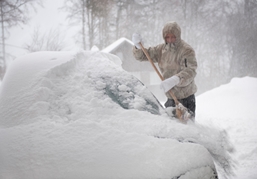Be Prepared for a Blizzard
Severe snowstorms can be lethal. Entire cities or whole regions can be immobilized by heavy snow, even interrupting the flow of supplies and of emergency and medical services. Buildings can collapse, trees and power lines can come down, and in rural areas, homes may be isolated for days. Blizzards are particularly dangerous because they include heavy snow driven by winds of at least 35 miles per hour, reducing visibility to near zero.
Preparation is the key to preventing blizzard consequences. Make sure you take action to safeguard your home, car and family before the winter season.
Home and Family
-
Winterize your home by insulating, using weatherstripping and caulking, and installing storm windows.
-
Create an emergency kit that has enough supplies for three to seven days. In it should be at least one gallon of water daily per person, non-perishable packaged or canned food and juices, handheld can opener, cooking tools/fuel, paper plates and plastic utensils, blankets and pillows, seasonal clothing and snow gear, a first-aid kit, medications and prescriptions, toiletries, battery operated flashlights and radio with spare batteries, and cash because banks and ATMs may not be available. Make sure your cell phone is fully charged.
-
Have a plan ahead of time to help elderly or disabled friends, neighbors or employees.
-
Stock up on salt and make sure you have a shovel.
Prepare Your Car
-
Keep antifreeze at proper levels.
-
Have a full tank of gas.
-
Windshield wipers should be in working condition. Check to make sure washer fluid is at the full level.
-
Carry a vehicle emergency kit that includes warm clothing and a blanket, a scraper and shovel, a flashlight with extra batteries and jumper cables.
Dress for the Weather
-
Wear several layers of loose fitting, lightweight, warm clothing.
-
Wear a hat and mittens.
-
Cover your mouth with a scarf to protect you lungs.
-
Stay dry. Change wet clothing to prevent a loss of body heat.
When a Snowstorm Hits
-
Listen to the radio or television for weather updates.
-
Avoid overexertion when shoveling snow.
-
Watch for signs of frostbite.
-
Drive a vehicle only if necessary and be aware of evacuation routes.
-
Know your area’s emergency plans, and where warming centers will be.









